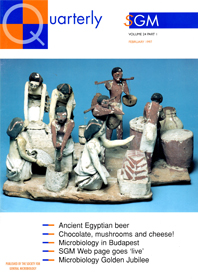Microbiology in food and drink
01 February 1997 publication
The lead articles of the February 1997 issue of SGM Quarterly are on ancient Egyptian beer; chocolate, mushrooms and cheese; and microbiology in Budapest.
Fermentation technology 3,000 years ago – the archaeology of ancient Egyptian beer (p. 03)
Delwen Samuel dsecribes one of the earliest examples of biotechnology – brewing!
Microbiology and physiology of cocoa fermentation (p. 06)
Chocolate can only be produced after a complex natural fermentation. Rosane Freitas Schwan explains how understanding of this process is leading to improvements in the quality of the product.
Mushrooms (p. 08)
Mushrooms are an important and undervalued food crop. Tim Elliott discusses how they can convert low value wastes into high value food and provide dietary variety.
Cheese (p. 10)
In this age where the manufacture of foods using products of genetic modification is upon us, Fran Mulholland describes how cheese, together with bread, wine and beer, can be considered one of the original biotechnologies.
Stationary phase: entry, residence and exit (p. 16)
The Main Symposium at the Microbiology Society meeting at the University of Essex in September 1996 addressed new ideas about stationary phase in both prokaryotes and eukaryotes. Alan Wheals explains what it is and the new ideas.
Report of the First Young Life Scientist of the Year Award (Promega Prize) (p. 24)
Grace Alderson reports back from the first Young Life Scientist of the Year Award event that took place at the Joint Congress of the British Society for Immunology and the Biochemical Society in December 1996.
International Development Fund Award report (p. 28)
Joseph Ongrádi talks about a practical course in microbiology in Hungary, which was made possible through the Society's International Development Fund.
Golden jubilee for Microbiology (p. 32)
It has been 50 years of publication for Microbiology and its previous incarnation, the Journal of General Microbiology. Jon Saunders writes a short history to commemorate.

